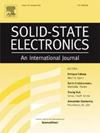碳化硅二极管重离子诱导降解及灾变燃尽机理研究
IF 1.4
4区 物理与天体物理
Q3 ENGINEERING, ELECTRICAL & ELECTRONIC
引用次数: 0
摘要
采用205-MeV Ge离子和283-MeV I离子的辐照实验和模拟,分析了SiC二极管的单事件泄漏电流(SELC)和单事件烧蚀(SEB)机理。在两种选定的重离子辐照下,随着SEB的发生,产生了安培量级的脉冲电流。微观分析发现SEB区覆盖了阳极金属、外延层和衬底,对器件的正向和反向特性都造成了破坏。用5 × 106 n·cm−2的浓度为205 mev的Ge离子照射器件,在200 V和300 V的反向偏置电压下,击穿电压分别降低了70%和82%。SELC器件的阳极触点存在局部断裂和位移,导致击穿特性下降。蒙特卡罗模拟和TCAD模拟相结合发现,当两种选定的重离子入射时,SEB临界温度首先出现在阳极接触附近。当选取的两种重离子在200 V偏置电压下从肖特基触点和欧姆触点入射时,局部温度过高以及不同阳极材料之间的温差导致阳极触点断裂和位移。本文章由计算机程序翻译,如有差异,请以英文原文为准。
Investigation of heavy-ion induced degradation and catastrophic burnout mechanism in SiC diode
Irradiation experiment and simulation of 205-MeV Ge ion and 283-MeV I ion were used to analyze the single event leakage current (SELC) and the single event burnout (SEB) mechanism of SiC diode. Under two selected heavy ion irradiations, the ampere-magnitude pulse current were generated along with the occurrence of SEB. The SEB area was found to cover the anode metal, epitaxial layer and substrate in microscopic analysis, which resulted in damage to the forward and reverse characteristics of device. Devices were irradiated by 205-MeV Ge ion with a fluence of 5 × 106 n·cm−2, under 200 V and 300 V reverse bias voltages, the breakdown voltage were degraded by 70 % and 82 % respectively. The anode contacts of SELC devices had local fractures and displacements, which led to the degradation of breakdown characteristics. Combined Monte Carlo simulation and TCAD simulation, the SEB critical temperature appeared near the anode contact firstly when the two selected heavy ions were incident. When the two selected heavy ions were incident from Schottky and Ohmic contacts at a bias voltage of 200 V, excessive temperature in local areas and temperature differences between different anode materials caused the fractures and displacements of anode contact.
求助全文
通过发布文献求助,成功后即可免费获取论文全文。
去求助
来源期刊

Solid-state Electronics
物理-工程:电子与电气
CiteScore
3.00
自引率
5.90%
发文量
212
审稿时长
3 months
期刊介绍:
It is the aim of this journal to bring together in one publication outstanding papers reporting new and original work in the following areas: (1) applications of solid-state physics and technology to electronics and optoelectronics, including theory and device design; (2) optical, electrical, morphological characterization techniques and parameter extraction of devices; (3) fabrication of semiconductor devices, and also device-related materials growth, measurement and evaluation; (4) the physics and modeling of submicron and nanoscale microelectronic and optoelectronic devices, including processing, measurement, and performance evaluation; (5) applications of numerical methods to the modeling and simulation of solid-state devices and processes; and (6) nanoscale electronic and optoelectronic devices, photovoltaics, sensors, and MEMS based on semiconductor and alternative electronic materials; (7) synthesis and electrooptical properties of materials for novel devices.
 求助内容:
求助内容: 应助结果提醒方式:
应助结果提醒方式:


